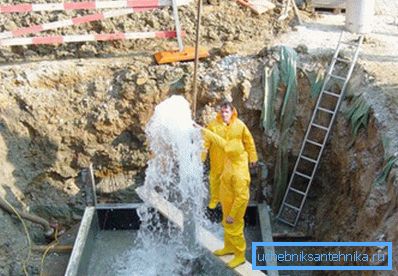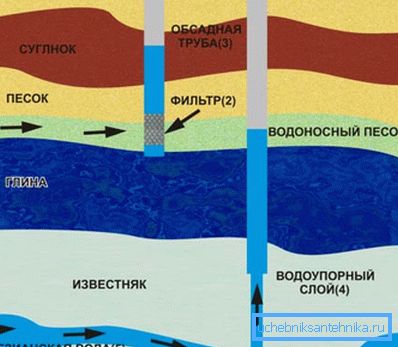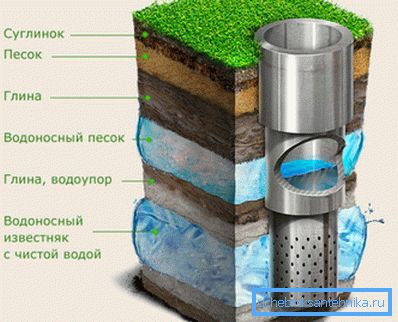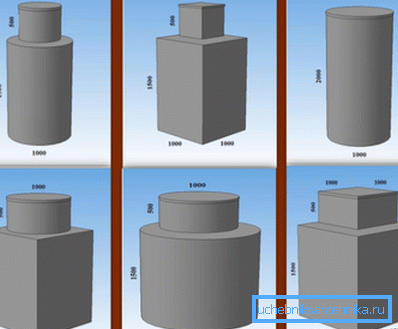The correct device wells for water
The organization of autonomous water supply is a very responsible and troublesome thing. In addition to drilling, which in itself is a daunting task, it includes many other arrangements for the development of the aquifer system. However, nothing is impossible, and then we will look at how it happens and how the well is being made with its own hands.

Types of groundwater
First of all, it should be said that groundwater is of several types. This is due to the fact that the rocks are arranged in layers. Between the water-resistant rocks just are aquifers, of course, they are located at different depths.
Groundwater located above the first waterproof layer is the least quality, not suitable for drinking, because they contain a lot of harmful impurities. Therefore, for autonomous water supply, interstitial waters are used, which have a more stable chemical composition.
However, interstitial aquifers are also different:
- First interlayer horizon, which is also called sandy, is usually located at a depth of 15–35 meters;
- Second limestone horizon, located much deeper - up to 200 meters or more.

As a rule, the wells are drilled up to the first interstratal horizon, since it is located much higher, so you can equip the well yourself. However, such a well has less water loss (debit), and it is also less durable.
The device of a deep well, or as they are called - artesian, is much more labor-intensive work, which requires special equipment and the qualification of drillers. Accordingly, it is physically impossible to drill such a well yourself.
Now let's take a closer look at the features of each type of wells.

Well in the sand
The main advantage of such a well, as already mentioned, is the possibility of its independent implementation.
However, it has almost all the drawbacks of an ordinary well:
- Debit can be much less than expected.
- As a result of seasonal fluctuations in water, the amount of water may periodically dry up or decrease.
- There is no guarantee that the water will be suitable for drinking.
- Over time, silts up.
- The term of operation, most often, does not exceed 15 years.
Note! Do not use water without performing an analysis. It may not seem drinkable and cause serious harm to health.

Artesian well
The artesian well device looks much more attractive, since it has several advantages:
- High water loss. Often, one well provides water to several houses at once.
- If the drilling and development was carried out with high quality, then the system can serve 50 or even more years.
- The water level does not depend on the season or the weather conditions. Therefore, even in the hottest summer you will be provided with the necessary amount of cool water.
- Artesian water is much cleaner and better than that extracted from the sandy aquifer.
It would seem that the choice of a well is obvious, however, it is not always advisable to carry out an artesian well, since the cost of its arrangement is very high. In addition, before starting work, you must obtain a license, as artesian water is considered a natural resource. Therefore, for example, in the country, the best option would be a well on the sand.

Limestone well device
Single tube design
Such a device artesian wells involves the presence of a casing, which at the same time performs the function of the production bore. It sinks to the level of a layer of limestone. Casing deeper does not make sense, since limestone is resistant to deformation.
For the casing, as a rule, a metal pipe with a diameter of 159 or 133 mm is used. Most often, the water level in the artesian well rises above the middle of the column, so the pump can be immersed at two thirds of the depth of the well, which is about the edge of the casing.

Double Casing Design
A device of this type of construction is distinguished by the use of an additional casing in the area of dry limestone, since it contains layers of clay. In this case, the metal casing pipe is brought to limestone, as in the first case, after which a PVC pipe is placed into it, which passes through dry limestone and is brought almost to the aquifer.
This design has a metal casing with a diameter of 159 or 133 mm, inside of which there is an operational plastic pipe of 133 or 117 mm in size.
Note! If the surface limestone is not completely stable, then the inner pipe should be planted to the very bottom.

Conductor construction
If the upper layers of the soil have quicksands, then the artesian well device assumes the presence of a conductor. This element is a pipe with a diameter larger than the casing. The conductor is installed in the upper part of the soil and thus protects the casing from the pressure of quicksters.
In this case, it is convenient to connect the conductor with the walls of the caisson, which we describe below.

Telescopic design
The name of this design speaks for itself - several casing pipes of different diameter are used. Such a system is used because of too dense or unstable soils in front of a layer of limestone.
The first metal pipe has the largest diameter, it is lowered to the layer of boulders. Then the second pipe passes through it to the level of the first layer of limestone. If there are clay in the limestone, then a plastic pipe is lowered through it to the aquiferous limestone.
Sand hole device
To install a well on the sand, it is necessary to drill the soil before the sand aquifer.
As a rule, the layers are arranged in the following order:
- Surface land;
- Sand,
- Clay layer
- Aquiferous sand.
Depending on the saturation of the aquifer, the well can be drilled to the middle of the aquifer, or to its bottom. After completion of drilling, a casing with a filter at the end is immersed in the well. In some cases, casing pipes are used in the drilling process.
Now let's take a closer look at the device of such a well:
- At the bottom of the column is a filter that does not pass sand, earth and clay into the working area. The filter is either external or embedded in the pipe, i.e. small holes are applied to the pipe itself.
- A sump is located above the filter.
- The pump, as in the case of artesian wells, is located approximately in the middle of the column.

Aquifer well system
In order for the structure to function as intended, it is not enough to perform only one hole in the ground. It is also necessary to ensure its delivery to the destination, for which the aquifer system is responsible. It should be said that it does not differ, regardless of the type of well.
The main element of the aquifer system is a pump that lifts the water up the hose.
Pumps are of two types:
- Deep - the device is lowered into the well itself. Therefore, these pumps have a narrow cylindrical shape, since the diameter of the casing is small. As mentioned above, submersible pumps are lowered to the middle of the well, where they draw water and direct it to the external water supply system.
- Surface pumps - installed in the caisson or in the house. If the pumping station is low-powered, it is better to install it in the caisson to facilitate the delivery of water from the well.
Note! The submersible pump must move freely in the casing, so there must be a gap of a few millimeters between it and its walls.
As a rule, reinforced hoses for food use are used as pipelines. Plastic and silicone sleeves are very popular.

Additional work for the well
If the drilling of the barrel and casing is usually entrusted to specialists, then the well is accomplished with its own hands. The fact is that a pipe with a hose sticking out of the ground is far from the best solution, both from an aesthetic and practical point of view - garbage will constantly get into the water, and in winter the system will just freeze and stop functioning.
Arrangement of well placement should begin with the installation of the caisson - waterproof insulated tank with the necessary equipment inside, which will ensure uninterrupted operation of the aquifer system. As a rule, the pump is located in the caisson (if it is not submersible), measuring instruments, valves, filters, automation and other elements of the system.
These structures can be made of different materials, but most often used:
- Plastic caissons - they are distinguished by good thermal insulation, so that even without additional insulation the temperature inside the structure is kept at 5 degrees Celsius. In addition, they are durable and do not require waterproofing. However, they have a low stiffness, therefore, it is desirable to pour it around the perimeter with cement.
- Steel - such designs are the most common. They are not difficult to make yourself from steel with a thickness of 4 mm. To design was durable, it must be treated with an anti-corrosion agent.
- Reinforced concrete - differ in durability and durability. At one time, these designs were the most common, however, due to the fact that the price of such a caisson is too high, recently they are used less frequently. In addition, the disadvantage of the product is its great weight.

A brief instruction on installing a metal caisson is as follows:
- First of all, it is necessary to dig a hole that will be 20-30 cm larger than the structure. The depth is calculated in such a way that the caisson neck rises 15 cm above the soil level.
- The next step is to mount the casing liner. To do this, a hole is cut in the bottom of the tank and a sleeve (a piece of pipe) 10-15 cm long is welded. The diameter of the sleeve, respectively, must be larger than the diameter of the casing.
- Then nipples are installed in the wall of the tank for the withdrawal of water pipes.
- Before installing the caisson, the casing pipe is cut at ground level, after which a container is put on it.
- Capacity in the pit is installed strictly vertically and secured with bars. After that, you can put in the construction of water supply, after which the connection of the aquifer system.
After installing the caisson, you can do the site decoration. It is possible to decorate a zone of a well in the different ways, it is possible to learn about it in more detail on our portal.
Tip! An excellent option for improvement of the well is to install a wooden house above the caisson.
Conclusion
If you understand the nuances, it turns out that the device wells is nothing complicated. However, the only condition for obtaining high-quality clean water is strict adherence to technology.
Additional information on this topic can be obtained from the video in this article.